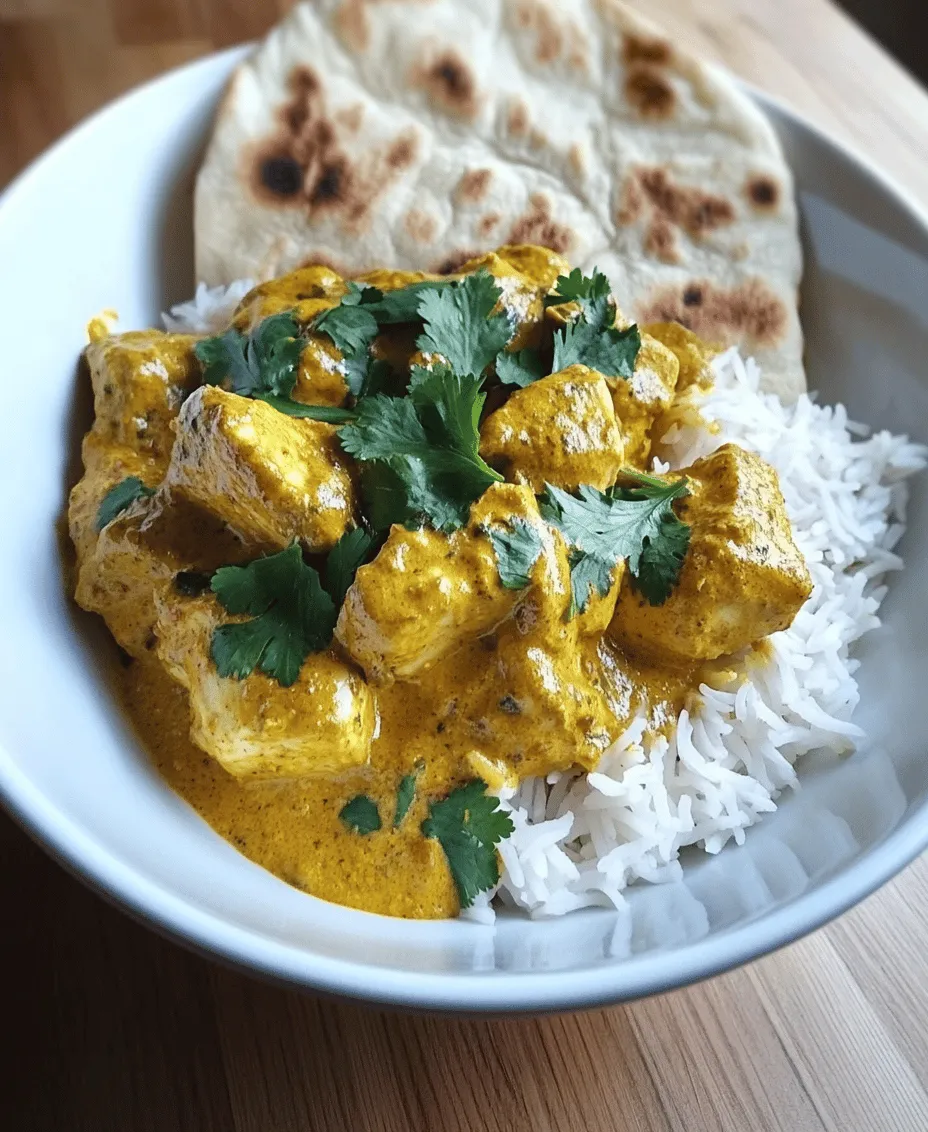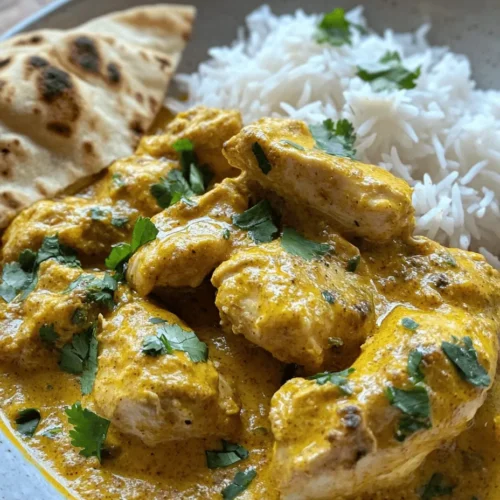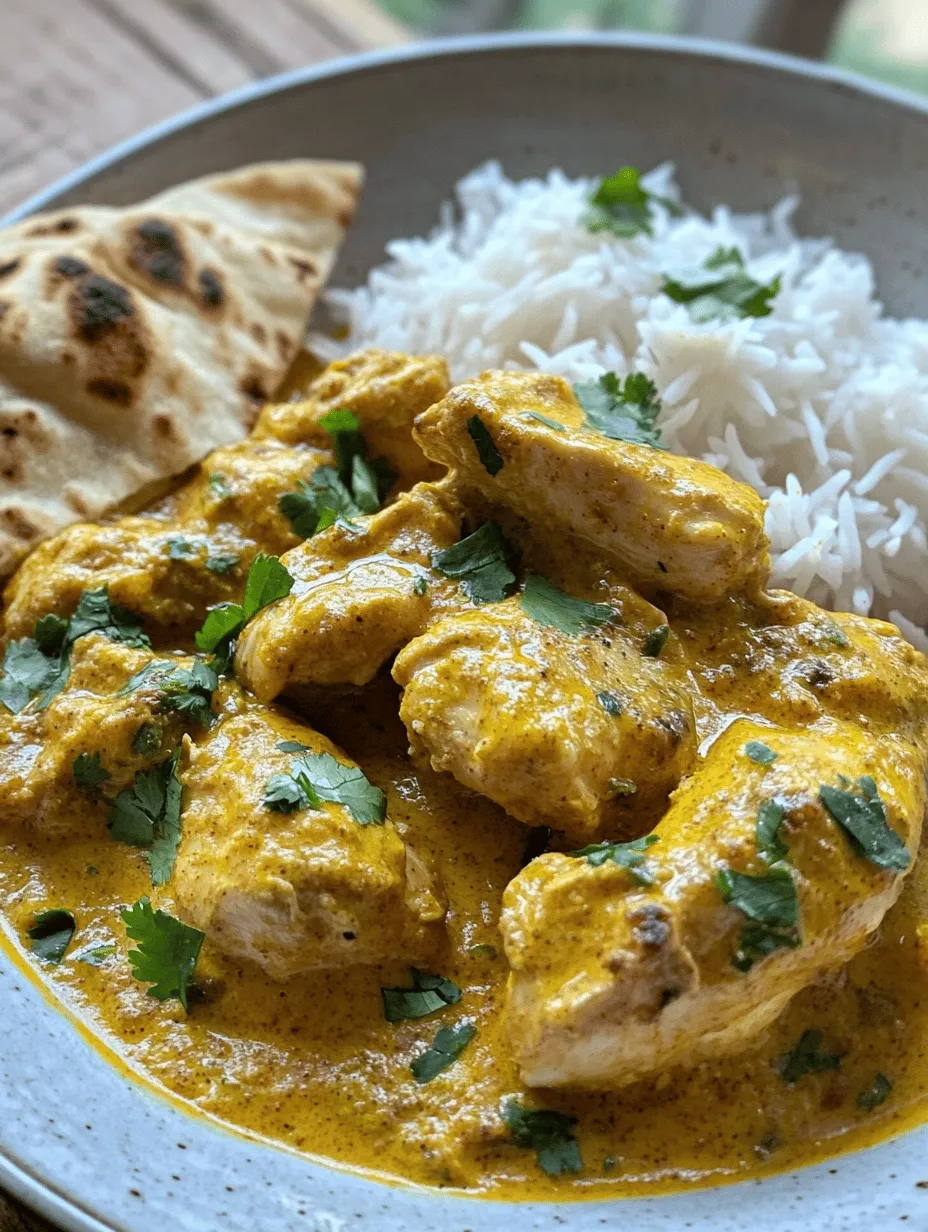Delve into the vibrant and aromatic world of Indian cuisine with Gordon Ramsay’s Authentic Chicken Tikka Masala. This dish is more than just a meal; it’s an experience steeped in rich flavors and creamy textures that transform simple chicken into a culinary masterpiece. Whether you’re a seasoned home cook or a beginner looking to impress friends and family, this recipe guides you through each step to create a satisfying meal that captures the essence of traditional Indian cooking.
Chicken Tikka Masala is renowned for its unique blend of spices and creaminess, offering a balance of heat and richness that appeals to a wide audience. Its popularity has soared globally, becoming a staple in many households and Indian restaurants alike. With Gordon Ramsay’s expert guidance, you can master this beloved dish and bring a taste of India to your dining table.
Understanding the Essence of Chicken Tikka Masala
To truly appreciate Chicken Tikka Masala, it’s essential to explore its origins and significance in Indian cuisine. This dish is thought to have originated in the Indian subcontinent, likely as a result of the British influence on Indian culinary traditions during the colonial era. While its exact origins are debated, many believe that it was created in a restaurant in the UK, where chefs adapted traditional Indian recipes to cater to Western tastes.
The essence of Chicken Tikka Masala lies in its combination of marinated chicken, grilled to perfection, and a rich, spiced tomato-based sauce. The dish encapsulates the vibrant flavors of Indian cooking, showcasing the importance of spices and marination in achieving depth of flavor. As it has evolved over the years, Chicken Tikka Masala has become a symbol of the fusion of Indian and Western culinary traditions, making it a beloved dish worldwide.
Key Ingredients for a Flavorful Experience
To recreate Gordon Ramsay’s Authentic Chicken Tikka Masala, understanding the key ingredients is crucial. Each component plays a vital role in achieving the dish’s signature flavor profile. Here’s a closer look at the essential ingredients that make this Chicken Tikka Masala stand out:
Chicken
The ideal cut for Chicken Tikka Masala is boneless, skinless chicken thighs. Thighs are preferred over breasts due to their higher fat content, which keeps the meat juicy and tender during cooking. The marination process enhances the chicken’s flavor and texture, making it an integral part of the dish.
Spices
Fresh spices are the backbone of Chicken Tikka Masala. The blend typically includes garam masala, cumin, and coriander, each contributing distinct flavors. Garam masala, a mix of spices like cardamom, cinnamon, and cloves, adds warmth and complexity, while cumin offers an earthy undertone. Coriander adds a hint of citrus and freshness, creating a well-rounded spice profile.
Yogurt and Lemon Juice
Yogurt and lemon juice are critical for the marination process. The yogurt acts as a tenderizer, breaking down the proteins in the chicken, resulting in a more succulent texture. Meanwhile, the acidity from lemon juice enhances the flavor and helps to further tenderize the meat, ensuring that every bite is bursting with taste.
Coconut Milk
Coconut milk is used in the sauce to enhance its creaminess and richness. It balances the spices and adds a subtle sweetness that complements the dish’s overall flavor. The creaminess of the coconut milk makes the sauce velvety, providing a luxurious mouthfeel that pairs perfectly with the spiced chicken.
Marination: The Secret to Tender and Flavorful Chicken
The marination process is the secret to achieving tender and flavorful chicken in Chicken Tikka Masala. Not only does marinating infuse the chicken with robust flavors, but it also ensures the meat remains juicy during cooking. Here’s a step-by-step guide to marinating chicken effectively:
Step-by-step Guide to Marinating Chicken
1. Prepare the Marinade: In a large bowl, combine plain yogurt, lemon juice, minced garlic, grated ginger, and a blend of spices (garam masala, cumin, coriander, turmeric, and chili powder). Mix well to create a smooth marinade.
2. Add the Chicken: Cut the chicken thighs into bite-sized pieces, ensuring even cooking. Add the chicken to the marinade, ensuring that each piece is thoroughly coated.
3. Marinate: Cover the bowl with plastic wrap or transfer the mixture to a resealable plastic bag. Place it in the refrigerator to marinate.
How Long Should You Marinate?
For optimal flavor absorption, marinate the chicken for at least 1 hour, but preferably overnight. The longer the chicken sits in the marinade, the more flavorful and tender it will become. If you’re short on time, even a 30-minute marinade can impart some flavor, but for the best results, patience is key.
The Impact of Acidic Ingredients on Flavor and Texture
Acidic ingredients like lemon juice not only enhance the flavor of the chicken but also play a crucial role in the cooking process. They help to break down the proteins, resulting in a more tender bite. This transformation occurs as the acid denatures the proteins in the meat, allowing them to retain moisture during cooking. The combination of yogurt and lemon juice in the marinade creates a balanced acidity that elevates the overall taste of the Chicken Tikka Masala.
Searing Chicken to Perfection
Once marinated, the next step in the process is searing the chicken. This technique is crucial for achieving that perfect golden crust while ensuring the chicken remains juicy and tender inside. Here’s how to sear chicken effectively:
Choosing the Right Pan
Selecting the right pan is essential for proper searing. A heavy-bottomed skillet or cast-iron pan is ideal, as it retains heat well and distributes it evenly. This ensures that the chicken cooks uniformly and develops a beautiful crust.
Tips for Proper Searing
1. Preheat the Pan: Before adding the chicken, make sure the pan is hot. A properly preheated pan will help create a caramelized crust, enhancing the flavor and texture of the chicken.
2. Avoid Overcrowding: Cook the chicken in batches if necessary. Overcrowding the pan can lead to steaming rather than searing, which prevents the chicken from developing that desirable golden-brown crust.
3. Do Not Move the Chicken Too Soon: Allow the chicken to sear undisturbed for a few minutes before flipping. This will help achieve a nice crust. Once a crust forms, the chicken will easily release from the pan.
How to Avoid Steaming the Chicken
To prevent steaming the chicken during the searing process, it’s important to monitor the heat and avoid adding too much marinated chicken at once. If the chicken pieces are too close together, moisture will be trapped, resulting in steaming rather than searing. Cooking in smaller batches not only allows for better searing but also ensures that each piece of chicken is cooked to perfection.
By following these steps, you’ll be well on your way to creating Gordon Ramsay’s Authentic Chicken Tikka Masala. This dish not only offers a delightful fusion of spices and creamy textures but also allows you to immerse yourself in the rich culinary traditions of Indian cuisine. With each step, from marination to searing, you will gain a deeper appreciation for the art of cooking and the flavors that make Chicken Tikka Masala a beloved classic. As you continue to explore this recipe, you’ll find that it’s not just about following instructions; it’s about creating a memorable dining experience that you and your loved ones will cherish.

Crafting the Perfect Sauce
The sauce is the heart of Chicken Tikka Masala, a dish that has garnered love from food enthusiasts around the world. Mastering the sauce is essential for achieving the authentic flavors that Gordon Ramsay is known for. In this section, we’ll delve into the crucial elements of building flavors, particularly through the sautéing process, and the roles of onions and tomatoes in creating a rich, flavorful base.
The Role of Onions in Flavor Development
Onions are often the foundation of many savory dishes, and Chicken Tikka Masala is no exception. When sautéed, onions release their natural sugars, which caramelize and contribute to a deep, complex flavor. For this recipe, finely chop two medium onions and sauté them in a generous amount of ghee or oil over medium heat. The goal is to soften the onions and allow them to turn a beautiful golden brown.
As the onions cook, they will become translucent and begin to caramelize, which typically takes about 10-15 minutes. This process is crucial; it enhances the sweetness of the onions and adds a savory depth to the sauce. Stir them occasionally to prevent burning and ensure even cooking. The rich aroma that fills your kitchen at this stage is a sure sign that you’re on the right track.
Simmering Tomatoes: Why It Matters
Once the onions have caramelized, it’s time to introduce the tomatoes. Fresh tomatoes or canned tomatoes can be used, but the key is to let them simmer long enough to develop their flavors. Add approximately 400 grams of chopped tomatoes to the pan with the onions. If using fresh tomatoes, it is advisable to blanch and peel them first for a smoother sauce.
Simmer the mixture for about 15-20 minutes, allowing the tomatoes to break down and meld with the onions. This step is crucial for achieving a luscious sauce that clings beautifully to the chicken. As the tomatoes cook, they will release their juices, which will blend with the caramelized onions, creating a rich, flavorful base for the Chicken Tikka Masala.
Balancing Flavors with Seasoning
The final step in crafting the perfect sauce is seasoning. This is where you’ll add the spices that give Chicken Tikka Masala its signature flavor. Common spices include garam masala, ground cumin, coriander, turmeric, and chili powder. Incorporate these spices into the onion and tomato mixture, allowing them to toast for a minute or two. This helps release their essential oils and intensifies their flavors.
Don’t forget to season with salt and pepper to taste, as this will enhance all the flavors in your sauce. At this stage, it’s also possible to adjust the heat level by adding more chili powder if you prefer a spicier dish. Taste as you go; the balance of flavors should be a harmonious blend of sweetness, acidity, and heat.
Bringing It All Together: Combining Chicken and Sauce
Now that you have an aromatic sauce ready, it’s time to bring everything together. This section emphasizes the final cooking steps, ensuring the chicken is perfectly integrated into the sauce for a cohesive dish.
Understanding Cooking Times for Chicken
The marinated chicken pieces should have been grilled or baked prior to mixing into the sauce. The cooking time for the chicken should be closely monitored to ensure it remains tender and juicy. If you are using pre-cooked chicken, simply simmer the chicken in the sauce for about 10-15 minutes. If using raw chicken, it will require a bit longer, around 20-25 minutes, depending on the size of the pieces.
It’s essential to stir occasionally, ensuring that every piece of chicken is coated in sauce and receives the necessary heat. Avoid overcooking, as this can lead to dryness. The chicken is done when it reaches an internal temperature of 165°F (75°C).
The Role of Coconut Milk in Texture and Flavor
To achieve that signature creaminess that Chicken Tikka Masala is famous for, it’s time to add coconut milk. Pour in approximately 200-250 ml of coconut milk into the sauce and stir well. This not only adds a luscious texture but also balances out the spices, making the dish rich and comforting.
Allow the coconut milk to simmer with the chicken for a few minutes. This helps to meld all the flavors together and creates a velvety sauce that clings perfectly to the chicken. If you prefer a thicker sauce, let it simmer uncovered for a bit longer to reduce.
Adjusting Seasonings for Personal Taste
Once everything is combined and simmering, it’s crucial to taste the dish one last time. This is your opportunity to fine-tune the flavors to your liking. If it tastes too spicy, consider adding a touch more coconut milk to mellow the heat. If it’s lacking in depth, a pinch more salt or a dash of garam masala can elevate the flavors.
Garnishing and Serving Suggestions
Presentation is key when serving Chicken Tikka Masala. A well-garnished dish not only looks appealing but also enhances the overall dining experience. Here are some tips on how to elevate your serving style.
The Significance of Fresh Coriander
Fresh coriander (cilantro) adds a burst of color and freshness to your Chicken Tikka Masala. Chop a handful of fresh coriander leaves and sprinkle them generously over the dish just before serving. This not only adds a vibrant green touch but also contributes a fresh flavor that balances the richness of the sauce.
Ideal Accompaniments: Basmati Rice and Naan Bread
Traditionally, Chicken Tikka Masala is served with basmati rice or naan bread. Basmati rice is a fragrant long-grain rice that complements the bold flavors of the dish perfectly. Cook the rice according to package instructions, ideally using a bit of salt and a splash of lemon juice for additional flavor.
Naan bread, on the other hand, is perfect for scooping up the chicken and sauce. Whether you opt for store-bought or homemade naan, serving it warm will enhance your dish’s overall experience. If you’re feeling adventurous, try making garlic naan by brushing the bread with garlic butter before serving.
Serving Tips for a Restaurant-Style Experience
For a restaurant-style presentation, consider serving your Chicken Tikka Masala in a shallow bowl, allowing the vibrant colors of the dish to shine. A sprinkle of fresh coriander and a wedge of lemon on the side can elevate the visual appeal. You may also serve with a side of cucumber raita, a cooling yogurt-based condiment that balances the spiciness of the masala.
Nutritional Information and Serving Size
Understanding the nutritional benefits of the ingredients in your Chicken Tikka Masala can help you make informed choices when planning your meal. Here’s a brief overview:
Health Benefits of Key Ingredients
– Chicken: A great source of protein and essential nutrients, chicken is low in fat (especially when skinless) and packed with vitamins such as B6 and niacin.
– Tomatoes: Rich in antioxidants, particularly lycopene, tomatoes promote heart health and skin health. They also provide vitamin C and potassium.
– Coconut Milk: While higher in calories and fat than dairy, coconut milk is a good source of medium-chain triglycerides (MCTs), which may offer health benefits such as improved metabolism.
– Spices: Many spices used in Chicken Tikka Masala, such as turmeric and cumin, have anti-inflammatory properties and can aid digestion.
Caloric Breakdown per Serving
A typical serving of Chicken Tikka Masala (approximately 1 cup) contains about 400-500 calories, depending on the specific ingredients and cooking methods used. This includes the chicken, sauce, and coconut milk.
When paired with a serving of basmati rice (about 1 cup), you can expect the total caloric intake to rise to around 600-700 calories. Adjusting portion sizes or using lower-fat alternatives can help tailor this dish to fit your dietary preferences.
Conclusion: Enjoying Your Homemade Chicken Tikka Masala
Creating Gordon Ramsay’s Authentic Chicken Tikka Masala is a rewarding culinary journey that combines skill, patience, and a passion for flavor. From marinating the chicken to crafting a rich sauce and presenting it beautifully, each step is an opportunity to deepen your understanding of cooking techniques and flavors.
As you savor each bite of this flavorful dish, take a moment to appreciate the effort you’ve put into mastering a classic recipe that promises to impress and delight any palate. Whether enjoyed on a weeknight with family or as a centerpiece for entertaining guests, this Chicken Tikka Masala is sure to become a favorite in your household.
Embrace the joy of cooking and sharing this dish with loved ones, celebrating the flavors and traditions that make this recipe a beloved classic. So gather your ingredients, roll up your sleeves, and get ready to indulge in an authentic culinary experience that brings the vibrant tastes of Indian cuisine right to your table.



